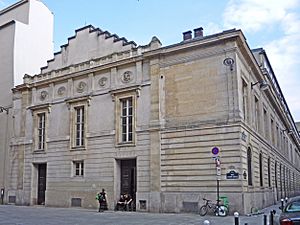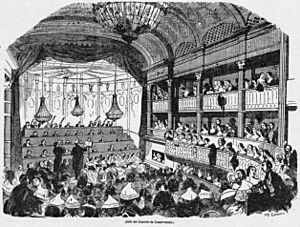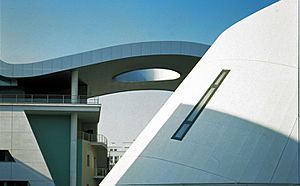Conservatoire de Paris facts for kids
|
Conservatoire national supérieur de musique et de danse de Paris (CNSDMP)
|
|

Current home of the CNSMDP
|
|
| Type | Grande école |
|---|---|
| Established | 1795 |
| Affiliation | PSL University |
| Director | Émilie Delorme |
| Address |
209 avenue Jean-Jaurès
,
Paris
,
,
75019
,
France
|
| Campus | Urban |
 |
|
The Conservatoire de Paris is a famous music and dance school in Paris, France. It was started in 1795. Its full name is the Conservatoire National Supérieur de Musique et de Danse de Paris (CNSMDP). This school teaches students music and dance, following a special 'French School' style.
Long ago, the Conservatoire also taught acting. But in 1946, the acting part became a separate school called the Conservatoire National Supérieur d'Art Dramatique (CNSAD). Both schools are now supported by the French Ministry of Culture. They are also connected to PSL University. The CNSMDP also works with another music and dance school in Lyon, France.
History of the Conservatoire
The Conservatoire has a long and interesting history. It started from smaller schools that taught music and acting.
Early Singing and Acting Schools
In 1784, a school called the École Royale de Chant (Royal School of Singing) opened. It taught singing and later added acting classes. This school was located in Paris.
A few years later, in 1792, another school was created. It was called the Institut National de Musique. This school trained musicians for the National Guard bands. These bands were very popular for big public events.
Founding the Conservatoire
On August 3, 1795, the French government combined these two schools. This created the Conservatoire de Musique. It was led by Bernard Sarrette. The new school stayed in the same buildings. In October 1796, the first 351 students began their studies.
By 1800, many famous musicians taught at the Conservatoire. These included composers like Luigi Cherubini and Étienne Méhul. Violinists like Pierre Baillot also taught there.
Student Exams and Prizes
The Conservatoire has a special tradition for final exams called the concours. At the end of their studies, students perform for a jury. This jury includes professors and famous musicians. Students also have to do tasks like sight-reading music.
Students who show great skill can win the Premier Prix. This is like a diploma with high honors. Those who get the Deuxieme Prix also receive a diploma. They can choose to stay another year to try for the top prize. There were also honorable mentions called Accessit. Students who did not pass could try again.
The Concert Hall
A special concert hall was opened on July 7, 1811. It was shaped like a 'U' and could hold over 1000 people. Many people thought the hall had amazing sound. A French composer even called it the "Stradivarius of concert halls."
In 1828, a violin professor named François Habeneck started a concert society. This society held concerts in the hall for many years. The famous composer Hector Berlioz performed his Symphonie Fantastique there in 1830.
The Library
The Conservatoire's library was started in 1801. It moved to a large room above the entrance of the concert hall. The composer Hector Berlioz worked in the library for many years. He was the librarian from 1852 until he passed away in 1869.
Changes and Famous Directors
After some changes in the French government, the school closed for a short time. It reopened in 1816 as the École Royale de Musique.
One of the most famous directors in the 1800s was Luigi Cherubini. He led the school from 1822 to 1842. He made sure the school kept very high standards. Many great teachers worked under him.
Later, Daniel-François-Esprit Auber became director in 1842. During his time, teachers included famous composers like Adolphe Adam. In 1852, Camille Urso became the first female student to win a prize for violin.
Instrument Museum
The Conservatoire also has an instrument museum. It was started in 1861 with a collection of musical instruments. A historian named Gustave Chouquet helped to make the collection much bigger and better.
Challenges and New Leaders
During the Franco-Prussian War (1870-1871), the Conservatoire building was used as a hospital. After the war, Ambroise Thomas became the director. He stayed in the role until 1896. Some students, like the famous composer Claude Debussy, felt his leadership was a bit old-fashioned.
During this time, César Franck taught composition classes. Many of his students became important composers.
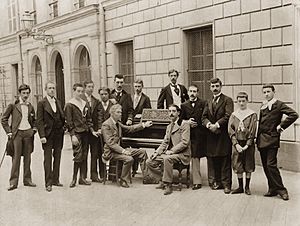
Théodore Dubois took over as director in 1896. Teachers included Gabriel Fauré for composition and Paul Taffanel for flute.
Gabriel Fauré's Leadership
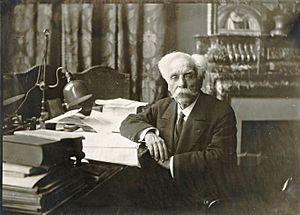
In 1905, Gabriel Fauré became the director. People had high hopes for him because he was an independent thinker.
Fauré brought in new ideas. He added classes like conducting and music history. His students included famous composers like Darius Milhaud and Arthur Honegger. Other notable students were Lili Boulanger and Nadia Boulanger.
The Modern Era
In 1911, the Conservatoire moved to a new building. Henri Rabaud became director in 1920. Famous students during this time included Olivier Messiaen.
During World War II, when France was occupied, the Conservatoire faced challenges. Leaders worked to protect students and teachers. Claude Delvincourt became director in 1941. He was a forward-thinking leader. He added new classes for instruments like the harpsichord and saxophone.
In 1946, the acting classes moved to a separate school. The Conservatoire of Music and Dance moved to a new, modern campus in 1990. This new campus is part of the Cité de la Musique.
In 2019, Émilie Delorme became the Conservatoire's first woman director. Today, the Conservatoire trains over 1,200 students. It has 350 professors in nine different departments.
CNSAD: The Drama School
The Conservatoire National Supérieur d'Art Dramatique (CNSAD) is the acting and drama school. It is located in the original historic building of the Conservatoire de Paris. Students often give free public performances in the CNSAD's theater.
CNSMDP: The Music and Dance School
The Conservatoire National Supérieur de Musique et de Danse de Paris (CNSMDP) is the separate school for music and dance. The French government built its new campus in the 19th arrondissement of Paris. It was designed by Christian de Portzamparc.
The campus has a large pipe organ. It was built in 1991 by an Austrian company. Another even larger organ was made in 2015 for the nearby Philharmonie de Paris symphony hall.
Images for kids
See also
 In Spanish: Conservatorio de París para niños
In Spanish: Conservatorio de París para niños


